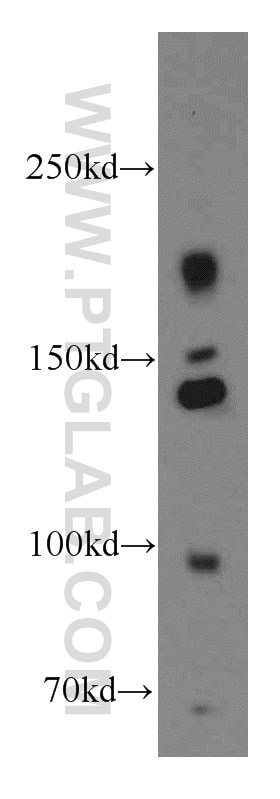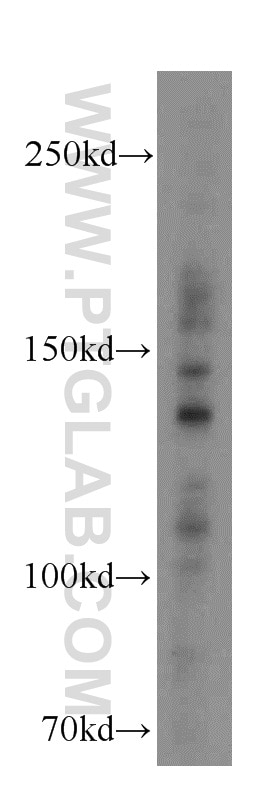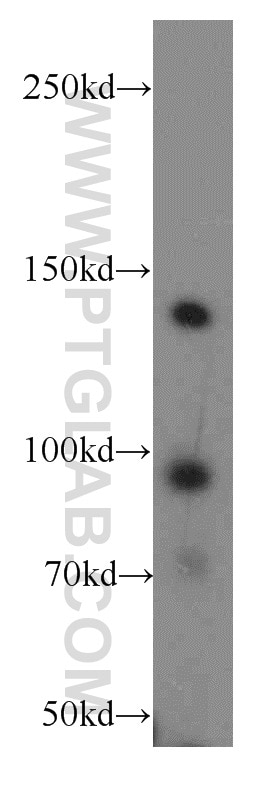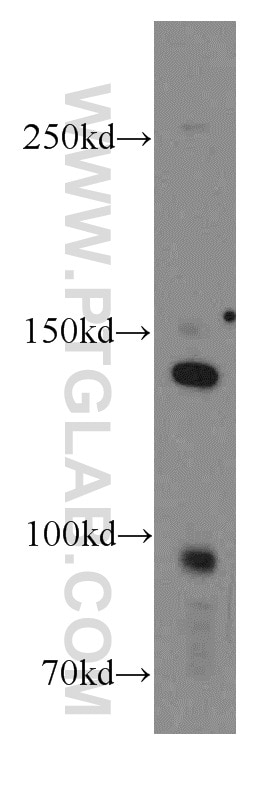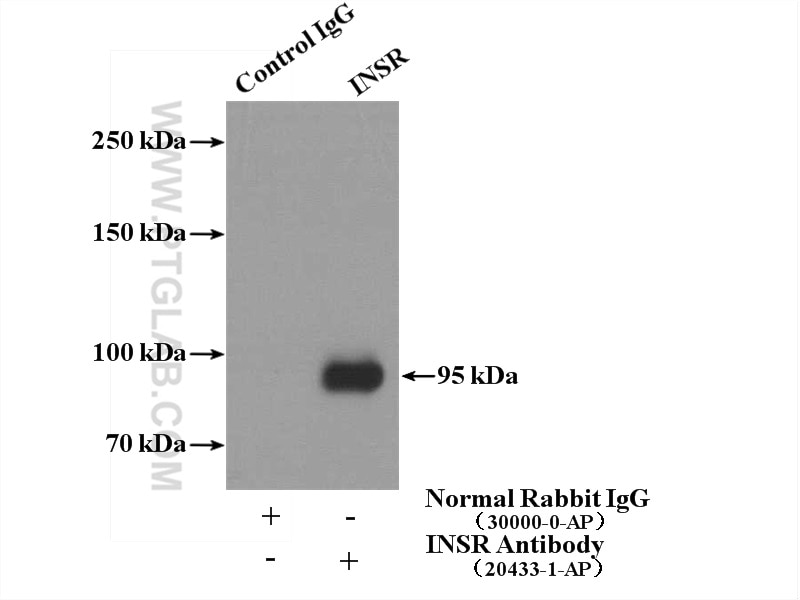Anticorps Polyclonal de lapin anti-INSR/CD220
INSR/CD220 Polyclonal Antibody for WB, IP, ELISA
Hôte / Isotype
Lapin / IgG
Réactivité testée
Humain et plus (5)
Applications
WB, IHC, IF, IP, CoIP, Dot blot, ELISA
Conjugaison
Non conjugué
N° de cat : 20433-1-AP
Synonymes
Galerie de données de validation
Applications testées
| Résultats positifs en WB | cellules HEK-293, cellules HeLa, cellules HT-1080, cellules MCF-7 |
| Résultats positifs en IP | cellules HeLa |
Dilution recommandée
| Application | Dilution |
|---|---|
| Western Blot (WB) | WB : 1:500-1:2000 |
| Immunoprécipitation (IP) | IP : 0.5-4.0 ug for 1.0-3.0 mg of total protein lysate |
| It is recommended that this reagent should be titrated in each testing system to obtain optimal results. | |
| Sample-dependent, check data in validation data gallery | |
Applications publiées
| WB | See 29 publications below |
| IHC | See 1 publications below |
| IF | See 1 publications below |
| CoIP | See 1 publications below |
Informations sur le produit
20433-1-AP cible INSR/CD220 dans les applications de WB, IHC, IF, IP, CoIP, Dot blot, ELISA et montre une réactivité avec des échantillons Humain
| Réactivité | Humain |
| Réactivité citée | rat, Humain, poisson-zèbre, porc, souris, fish |
| Hôte / Isotype | Lapin / IgG |
| Clonalité | Polyclonal |
| Type | Anticorps |
| Immunogène | INSR/CD220 Protéine recombinante Ag13922 |
| Nom complet | INSR |
| Masse moléculaire calculée | 1382 aa, 156 kDa |
| Poids moléculaire observé | 190 kDa, 135 kDa, 95 kDa |
| Numéro d’acquisition GenBank | BC117172 |
| Symbole du gène | INSR |
| Identification du gène (NCBI) | 3643 |
| Conjugaison | Non conjugué |
| Forme | Liquide |
| Méthode de purification | Purification par affinité contre l'antigène |
| Tampon de stockage | PBS with 0.02% sodium azide and 50% glycerol |
| Conditions de stockage | Stocker à -20°C. Stable pendant un an après l'expédition. L'aliquotage n'est pas nécessaire pour le stockage à -20oC Les 20ul contiennent 0,1% de BSA. |
Informations générales
The biological effects of INS are mediated by a membrane-spanning cell surface receptor that has been shown to consist of disulfide-linked alpha-subunits (135 kDa) and beta-subunits (95 kDa) that are cleaved products of a common precursor. The binding of INS to the receptor extracellular domain results in intracellular activation of a tyrosine-specific kinase activity and the generation of signals that determine the cellular response (PMID: 2369896). This antibody raised against 980-1382aa of human INS receptor can recognize full-length INS receptor precursor and INS receptor beta subunit.
Protocole
| Product Specific Protocols | |
|---|---|
| WB protocol for INSR/CD220 antibody 20433-1-AP | Download protocol |
| IP protocol for INSR/CD220 antibody 20433-1-AP | Download protocol |
| Standard Protocols | |
|---|---|
| Click here to view our Standard Protocols |
Publications
| Species | Application | Title |
|---|---|---|
Environ Health Perspect Effects of Chronic Secondhand Smoke (SHS) Exposure on Cognitive Performance and Metabolic Pathways in the Hippocampus of Wild-Type and Human Tau Mice. | ||
Int J Biol Macromol Lycium barbarum polysaccharide mitigates high-fat-diet-induced skeletal muscle atrophy by promoting AMPK/PINK1/Parkin-mediated mitophagy | ||
Food Funct l-Theanine regulates glucose, lipid, and protein metabolism via insulin and AMP-activated protein kinase signaling pathways | ||
Br J Surg MiR-128 regulation of glucose metabolism and cell proliferation in triple-negative breast cancer. | ||
FASEB J Angptl7 promotes insulin resistance and type 2 diabetes mellitus by multiple mechanisms including SOCS3-mediated IRS1 degradation. | ||
Sci Rep NaoXinTong Capsules inhibit the development of diabetic nephropathy in db/db mice. |
Avis
The reviews below have been submitted by verified Proteintech customers who received an incentive for providing their feedback.
FH Mi (Verified Customer) (05-29-2023) | It works well in human white adipocytes, we get strong signals
|
FH Chiara (Verified Customer) (10-04-2021) | Works well but three bands
|
FH Boyan (Verified Customer) (06-06-2021) | This antibody recognized a band at ~ 180 kd only, which is sensitive to PNGaseF, but not EndoH, treatment. The size is much bigger than an expected InsR band. Importantly, stripping the membrane and re-blot with another InsR antibody from a different brand could detect the protein at the expected MW. These results suggest this InsR antibody is detecting something other than InsR.
|
